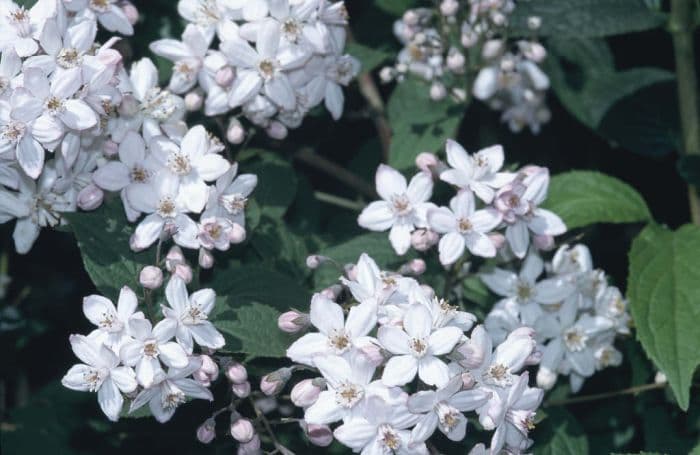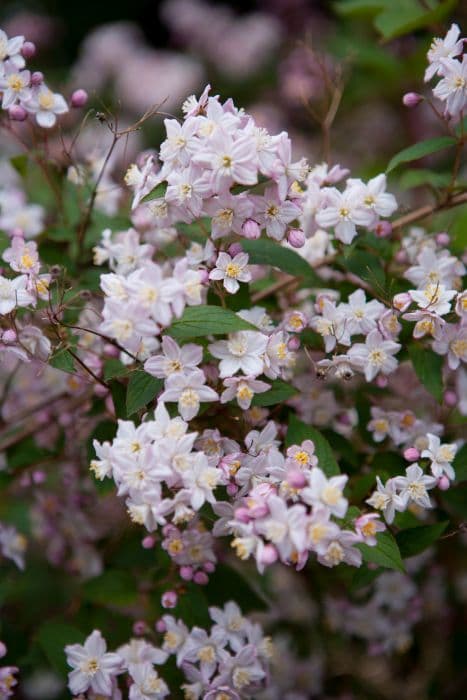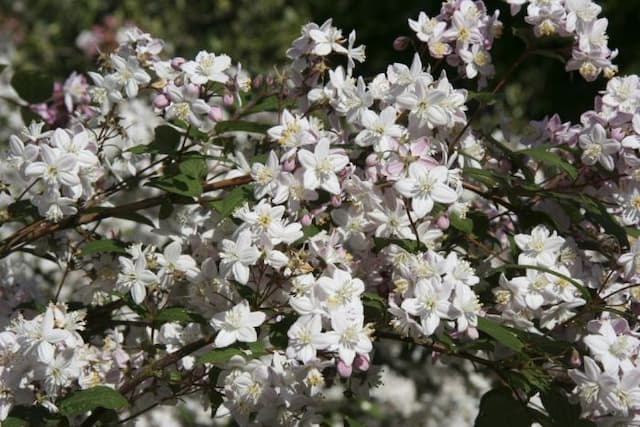Slender Deutzia Deutzia × hybrida 'Mont Rose'

ABOUT
Deutzia 'Mont Rose' is a deciduous shrub, notable for its dense, bushy habit and elegant appearance. Throughout the growing season, its foliage presents as a lush green, providing a beautiful backdrop for the abundant flowers that it produces. The leaves are simple and oval-shaped, with serrated edges that give the plant a textured look. The true show-stoppers of Deutzia 'Mont Rose' are its flowers, which appear in late spring to early summer. The blooms are formed in clusters known as corymbs and are composed of numerous small, star-shaped flowers. These blossoms are a delicate pink color, with a hue that can vary from a soft, almost pastel shade to a more vibrant rosy pink as they mature. Each flower has five rounded petals that unfurl from a central point to create an airy, buoyant effect that's both graceful and eye-catching. As the flowers fade, they leave behind a framework of branches that arch and overlap, adding to the plant's overall charm and making it a pleasing addition to garden landscapes. The aesthetic appeal of Deutzia 'Mont Rose' lies in its combination of delicate blooms and robust foliage, offering visual interest from spring through the fall leaf color transition. Its display of flowers and verdant leaves make it a favorite among gardeners looking to enhance the visual appeal of their outdoor spaces.
About this plant
 Names
NamesFamily
Hydrangeaceae
Synonyms
Slender Deutzia, Hybrid Deutzia
Common names
Deutzia × hybrida 'Mont Rose'.
 Toxicity
ToxicityTo humans
Deutzia is not known to be toxic to humans. While it is always advisable not to ingest parts of ornamental plants, Deutzia does not contain substances that are known to cause poisoning in humans if accidentally ingested. Therefore, there should be no specific symptoms of poisoning associated with this plant. However, as with any non-food plant, individual allergic reactions or gastrointestinal discomfort cannot be completely ruled out if parts of the plant are consumed.
To pets
Deutzia is also not known to be toxic to pets. It is not listed among the plants that are commonly known to cause poisoning in domestic animals such as cats and dogs. Thus, if a pet were to ingest parts of Deutzia, there should theoretically be no symptoms of poisoning specifically related to the plant. Nevertheless, ingestion of non-dietary items can sometimes result in mild stomach upset in pets, so monitoring for general signs of gastrointestinal distress, like vomiting or diarrhea, is prudent if ingestion is suspected.
 Characteristics
CharacteristicsLife cycle
Perennials
Foliage type
Deciduous
Color of leaves
Green
Flower color
Pink
Height
4-5 feet (1.2-1.5 meters)
Spread
4-5 feet (1.2-1.5 meters)
Plant type
Shrub
Hardiness zones
5
Native area
Asia
Benefits
 General Benefits
General Benefits- Ornamental appeal: Deutzia 'Mont Rose' offers a beautiful display of pink flowers that can enhance the aesthetic of any garden.
- Easy to grow: This plant is known for being low-maintenance and easy to care for, which makes it suitable for gardeners of all skill levels.
- Drought tolerance: Once established, Deutzia 'Mont Rose' can tolerate periods of drought, reducing the need for constant watering.
- Cold hardiness: It can withstand low temperatures, making it suitable for gardens in cooler climates.
- Attracts pollinators: The flowers of the Deutzia 'Mont Rose' are attractive to bees and butterflies, supporting local pollinator populations.
- Versatility: This plant can be used in a variety of landscape designs, including as an accent plant, in foundation plantings, or as part of a mixed border.
- Seasonal interest: Deutzia 'Mont Rose' provides seasonal interest with its spring blossoms and has attractive foliage that adds to the garden throughout the growing season.
- Fast growth: It is a fast-growing shrub, which allows it to quickly fill in garden spaces and achieve its full ornamental effect in a relatively short time.
- Good for wildlife: The shrub can provide shelter and nesting sites for birds and other wildlife within a garden ecosystem.
 Medical Properties
Medical PropertiesThis plant is not used for medical purposes.
 Air-purifying Qualities
Air-purifying QualitiesThis plant is not specifically known for air purifying qualities.
 Other Uses
Other Uses- Creating natural decorations: Deutzia Mont Rose can be dried and used in decorative displays or crafts due to its delicate and attractive flowers.
- Photography subject: This plant's vibrant pink blooms make it an excellent subject for photographers, particularly those specializing in botanical images.
- Teaching tool: Horticulture educators might use Deutzia Mont Rose to teach pruning techniques or to discuss hybrid plant characteristics.
- Garden design: Their particular growth habit and blossoming pattern make these plants ideal as 'living walls' to delineate or decorate different areas in a garden.
- Bee forage: When in bloom, the Deutzia Mont Rose provides a valuable source of nectar for bees, contributing to local biodiversity.
- Special events: Branches of Deutzia Mont Rose can be used in floral arrangements for weddings or other special events when they are in season.
- Nature-inspired art: Artists may take inspiration from the shapes and colors of Deutzia Mont Rose for paintings, illustrations, and textile designs.
- Backdrops: Dense bushy growth of the plant can provide a lush green backdrop in gardens for outdoor social gatherings or relaxation spaces.
- Educational research: Can be used in academic studies focusing on hybrid vigor or the ornamental plant breeding process.
- Landscape restoration: Deutzia Mont Rose can be included in projects that aim to restore a historically accurate setting in heritage gardens or estates.
Interesting Facts
 Feng Shui
Feng ShuiDeutzia is not used in Feng Shui practice.
 Zodiac Sign Compitability
Zodiac Sign CompitabilityDeutzia is not used in astrology practice.
 Plant Symbolism
Plant Symbolism- Purity: The delicate pink blooms of the Deutzia x hybrida 'Mont Rose', commonly known as Slender Deutzia, often symbolize purity due to their gentle appearance and pristine look.
- Humility: Slender Deutzia's unassuming growth habit and modest foliage can represent humility, reflecting the plant's simple yet graceful presence in a garden.
- Renewal: Like many flowering shrubs, the Slender Deutzia's cycle of blooming in the spring can symbolize renewal or new beginnings, as it marks the end of winter and the start of a vibrant new season.
 Water
WaterDeutzia, commonly known as Slender Deutzia, prefers evenly moist soil, so it's important to water it when the top inch of soil feels dry to the touch. Water the plant generously until excess water drains out of the bottom of the pot, which is often the equivalent of about 1-2 gallons for a medium-sized shrub over a week during active growth. In cooler seasons or when rainfall is ample, reduce the frequency accordingly. During hot summer months, it may require weekly watering, especially if it's not mulched. It's crucial not to overwater, as this can lead to root rot.
 Light
LightSlender Deutzia thrives best in full sun to partial shade. The ideal spot for this plant is one where it can receive at least 6 hours of sunlight daily, while being protected from the intense midday sun. An eastern or western exposure is ideal for providing the right balance of light.
 Temperature
TemperatureSlender Deutzia is hardy and can withstand a range of temperatures, typically from 20 to 75 degrees Fahrenheit. It's best to avoid exposure to extremes, with the ideal growth occurring at the moderate temperatures between 60 to 70 degrees Fahrenheit. When planting outdoors, it's essential to ensure the area does not frequently drop below 20 degrees, as colder temperatures can damage or kill the plant.
 Pruning
PruningPrune Slender Deutzia in late winter or early spring before new growth starts. This is to remove any dead or damaged branches and to shape the plant. It typically requires pruning once a year; however, rejuvenation pruning may be necessary every few years to maintain its vigor. To rejuvenate, cut back one-third of the oldest stems to ground level.
 Cleaning
CleaningAs needed
 Soil
SoilDeutzia, commonly known as deutzia 'Mont Rose', thrives in well-draining, fertile soil with a pH range of 6.0 to 7.5. A mix of loam, peat, and coarse sand or perlite is ideal, ensuring good moisture retention while allowing excess water to drain away.
 Repotting
RepottingDeutzias, or deutzia 'Mont Rose', generally do not require frequent repotting; it can be done every 2-3 years or when the plant has outgrown its current container, to refresh the soil and encourage continued growth.
 Humidity & Misting
Humidity & MistingDeutzia 'Mont Rose' prefers moderate humidity levels but is quite adaptable and can tolerate the humidity levels typically found in temperate outdoor environments without needing special attention.
 Suitable locations
Suitable locationsIndoor
Keep in bright, indirect light with room to grow.
Outdoor
Plant in sun or partial shade; shelter from strong winds.
Hardiness zone
5-8 USDA
 Life cycle
Life cycleDeutzia × hybrida 'Mont Rose', commonly known as Mont Rose Deutzia, begins its life as a dormant plant with buds on bare stems, typically emerging from a nursery pot. When planted in the ground in early spring, the initial growth stage involves the emergence of new leaves and stems, which is followed by a flowering period in late spring to early summer where clusters of pink flowers bloom. After pollination, which is usually facilitated by insects, the plant may produce small, inconspicuous fruit, although Deutzia is generally grown for its flowers rather than fruit. Post-bloom, the plant enters a vegetative growth phase, where it focuses on leaf and stem development to increase its size and photosynthetic capacity. As temperatures cool in autumn, growth slows and the plant starts to prepare for dormancy by shedding leaves. Finally, the plant overwinters in dormancy, with buds forming in readiness for the next growing season.
 Propogation
PropogationPropogation time
Spring-Early Summer
Propogation: The Deutzia × hybrida 'Mont Rose', commonly known as the Mont Rose deutzia, is most effectively propagated by softwood cuttings in late spring to early summer. This process involves cutting a young shoot that has not yet hardened, typically 4 to 6 inches (10 to 15 centimeters) long, with a sharp, clean pair of pruning shears. The cuttings should then have the lower leaves removed, and the base dipped in a rooting hormone powder or gel to encourage root development. Afterward, the cutting is then placed in a potting mix that is kept moist but not waterlogged. A plastic bag or a cover can help retain humidity around the cutting, which is beneficial for root formation. Under the right conditions, the cutting will develop roots within a few weeks, after which it can be transplanted to a larger pot or directly into the garden.







![Hydrangea [Early Sensation]](/_next/image?url=https%3A%2F%2Fplants-admin.emdemapps.com%2Fimages%2Fplants%2F%2Fimages%2F604b6150338db.png&w=640&q=75)

